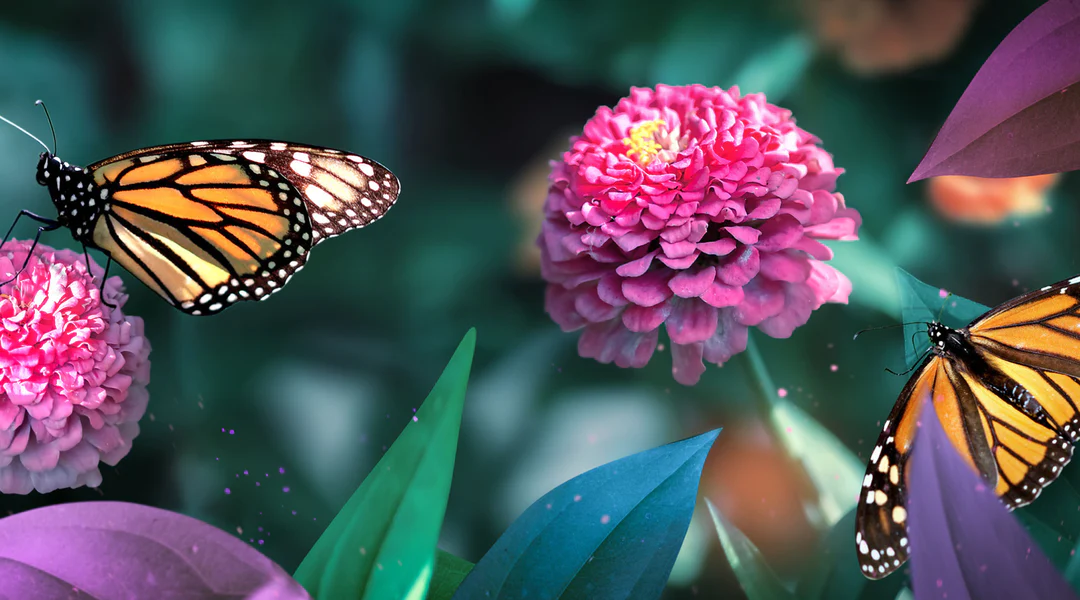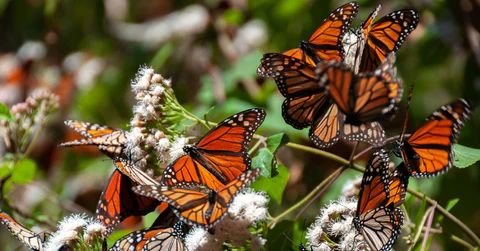Customer Support
We're here to help! Email us anytime at support@wildlifethreads.com
Customer Support
We're here to help! Email us anytime at support@wildlifethreads.com

Monarch butterflies are in big trouble. These iconic black-and-orange insects, which once migrated across North America in monumental numbers each spring, have seen their populations decline by 90 percent over the past 20 years. The culprit is habitat loss due to industrial agriculture and other human activities that have destroyed milkweed plants—the only plant on which monarchs lay their eggs and the only food source for monarch caterpillars.
It may seem like a daunting task to help save a species as large and beloved as the monarch butterfly, but there are simple steps you can take right now to help keep these beautiful creatures alive for generations to come! Here’s how:
Add native milkweed to your garden.
To plant milkweed, look for native species (which grow in the United States) that can be found at local nurseries or purchased from online retailers. These include common milkweed (Asclepias syriaca), butterfly weed (Asclepias tuberosa), swamp milkweed (Asclepias incarnata), and showy milkweed (Asclepias speciosa).
Milkweeds are easy to grow because they are hardy perennials that thrive in full sun or partial shade, once established. They don’t require much water and will even tolerate poor soil conditions—the kind you may have in your yard or garden! If you have less than ideal conditions, consider planting them in containers so they’ll have access to more nutrients and moisture than traditional pots allow. You can also place containers near a house foundation where there’s often better drainage than other areas of the yard.
Once planted, most species only need occasional watering during dry periods; but if your plants are suffering from insect damage, consider spraying them with neem oil every two weeks for three months during summer months when monarchs lay their eggs on them. Once the eggs hatch into caterpillars around mid-June through early July, be sure not to spray again until after late August or early September when most of these pests should have disappeared naturally because they won’t survive through winter temperatures here in North America!
Make your yard into butterfly habitat.
As the monarch butterfly’s host plant, milkweed is essential to the survival of monarch butterflies. Plant native milkweeds in your garden, or consider adding them to your landscaping. Remember that not all species of milkweed are safe for monarch caterpillars and their larvae to eat. Research which species are native to your area before you plant!
For nectar plants, try planting flowers that bloom at different times during the growing season so there will be food throughout the year. Some good examples include: spring-blooming asters; summer blooming lupines; fall blooming aster; winter blooming penstemons (Penstemon barbatus), columbines (Aquilegia spp.), and bluebells (Mertensia virginica). It’s also a good idea to leave some space in between each plant so they don’t compete with each other for sunlight or water resources. Don’t forget about deadheading spent flowers! This helps prevent overcrowding and encourages new growth from within existing stems instead of forming new ones from seeds scattered by birds or wind

Plant a monarch waystation.
A waystation is a garden or flowerbed that is planted with nectar-rich plants and maintained to support butterflies on their migration.
The best waystations are circular in shape, with the diameter of the circle determined by your current space. In general, you want it to be large enough that both you and the butterfly can move around comfortably without feeling crowded. For example, if you have a 10-foot diameter yard, your waystation should be at least 10 feet wide and tall as well.
You can plant multiple monarch waystations if you have more than one area where butterflies rest during their migration route (e.g., along your property line). If this is not an option for you, plant only one!
A good place for your monarch waystation is near an entrance or exit point of your yard—for example under trees so that when monarchs land there they don’t get trapped away from their path towards food sources nearby like flowers or other plants located further downwind from where they landed originally
Collect monarch caterpillars and release them as butterflies in your yard.
Collecting and releasing monarch caterpillars is an easy way to help butterflies. Collect the larvae in late summer and early fall, before they attach themselves to a branch with silk thread.
Hold the caterpillar in your hand, upside down (so it can’t crawl out), and set it on top of a leaf or stem that you’ve cut from another plant so it doesn’t get lost in your hand. Then gently place your thumb and forefinger under the bottom of its body and grasp its head between them with two fingers on either side of its mouth parts (where you would put food if you were feeding it). The little jaws will protrude slightly past these “tabs”—don’t worry—they won’t hurt you! Holding firmly but gently twist off their heads using whatever implement is handy–something like an apple corer works well for this purpose if nothing else is available at the time.)
Get involved with a conservation group like the Nature Conservancy, Xerces Society and the Monarch Joint Venture.
The Monarch Butterfly Habitat Conservation Plan is a collaborative effort between the U.S. Fish and Wildlife Service, the National Wildlife Federation and other organizations. You can get involved by joining a local conservation group like the Nature Conservancy or Xerces Society, donating money to a national organization like the United States Fish and Wildlife Service, volunteering your time to plant milkweed at schools or nature centers and educating others about monarchs.
Conclusion
We hope these tips will help you make your yard a butterfly garden. You can do it! It’s easy to plant native milkweed and nectar plants, and if you don’t have enough space in your yard, there are plenty of other ways to help out. If you really want to get involved, check out the Monarch Joint Venture’s website for more resources on how to create monarch habitat at home or in your community.
Discover art that speaks to you. Click on a category below to explore our curated collections on our Etsy store.